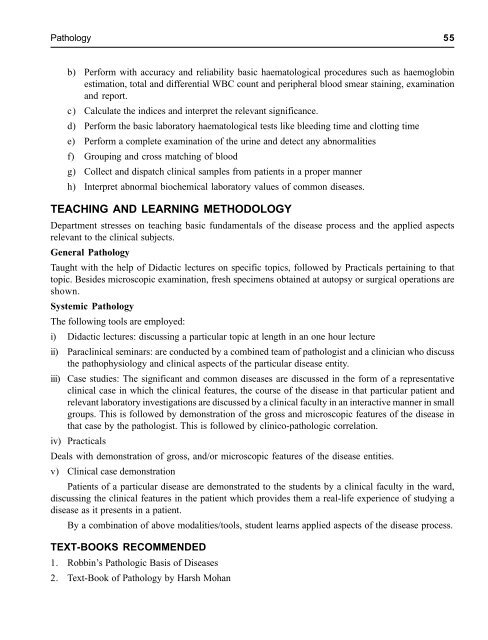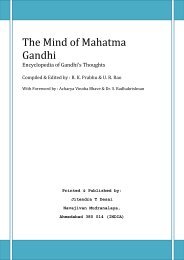Syllabus - MBBS
You also want an ePaper? Increase the reach of your titles
YUMPU automatically turns print PDFs into web optimized ePapers that Google loves.
Pathology 55<br />
b) Perform with accuracy and reliability basic haematological procedures such as haemoglobin<br />
estimation, total and differential WBC count and peripheral blood smear staining, examination<br />
and report.<br />
c) Calculate the indices and interpret the relevant significance.<br />
d) Perform the basic laboratory haematological tests like bleeding time and clotting time<br />
e) Perform a complete examination of the urine and detect any abnormalities<br />
f) Grouping and cross matching of blood<br />
g) Collect and dispatch clinical samples from patients in a proper manner<br />
h) Interpret abnormal biochemical laboratory values of common diseases.<br />
TEACHING AND LEARNING METHODOLOGY<br />
Department stresses on teaching basic fundamentals of the disease process and the applied aspects<br />
relevant to the clinical subjects.<br />
General Pathology<br />
Taught with the help of Didactic lectures on specific topics, followed by Practicals pertaining to that<br />
topic. Besides microscopic examination, fresh specimens obtained at autopsy or surgical operations are<br />
shown.<br />
Systemic Pathology<br />
The following tools are employed:<br />
i) Didactic lectures: discussing a particular topic at length in an one hour lecture<br />
ii) Paraclinical seminars: are conducted by a combined team of pathologist and a clinician who discuss<br />
the pathophysiology and clinical aspects of the particular disease entity.<br />
iii) Case studies: The significant and common diseases are discussed in the form of a representative<br />
clinical case in which the clinical features, the course of the disease in that particular patient and<br />
relevant laboratory investigations are discussed by a clinical faculty in an interactive manner in small<br />
groups. This is followed by demonstration of the gross and microscopic features of the disease in<br />
that case by the pathologist. This is followed by clinico-pathologic correlation.<br />
iv) Practicals<br />
Deals with demonstration of gross, and/or microscopic features of the disease entities.<br />
v) Clinical case demonstration<br />
Patients of a particular disease are demonstrated to the students by a clinical faculty in the ward,<br />
discussing the clinical features in the patient which provides them a real-life experience of studying a<br />
disease as it presents in a patient.<br />
By a combination of above modalities/tools, student learns applied aspects of the disease process.<br />
TEXT-BOOKS RECOMMENDED<br />
1. Robbin’s Pathologic Basis of Diseases<br />
2. Text-Book of Pathology by Harsh Mohan



